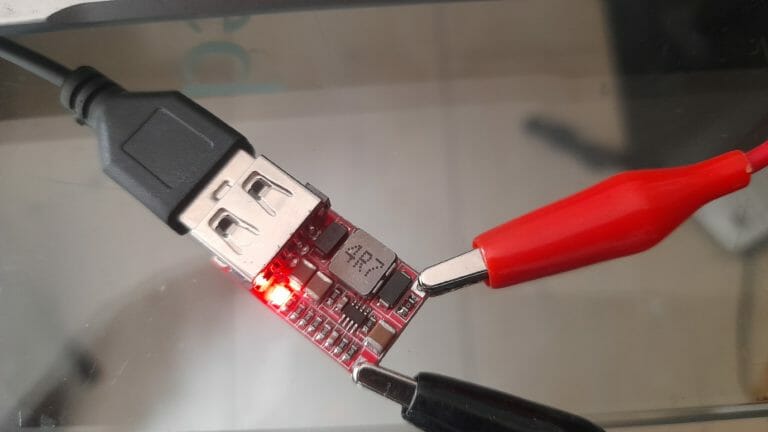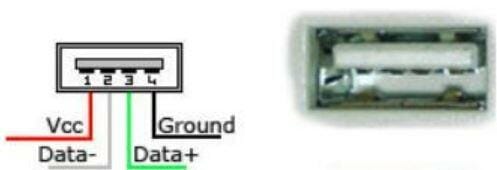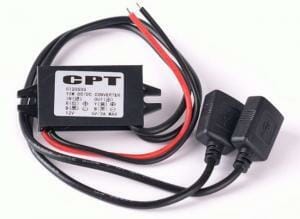Share in:
Occasionally we need to have to connect some small device inside our classic car. It can be a socket for charging a phone, a portable GPS, or any (semi)permanently installed device.
Nowadays, many of these devices come with a USB cable that is used to power the unit. USB (acronym for Universal Serial Bus) is an interface that was designed a few years ago to transmit data between devices quickly and capable of supporting connections/disconnections while the devices are still running.
In addition to this functionality, the USB connectors incorporate a permanent 5V signal between pins 1 and 4. This means that from the 4 USB pins, the two in the middle are data (signal and ground) and the two at the end are permanent 5V.
The type of USB connector we probably don't want/can't have on our classic
The fact that this type of connector has become a standard, and the need to make things cheaper, means that a large number of low-voltage devices do not have their own power supply and are therefore designed to be powered through a USB socket (which, let’s say everything, also has the advantage that we have finally have get rid of the endless number of power supplies that each gadget came with and that where quite a nightmare).
To avoid this, there are still adapters in the form of a small box that can be discreetly installed inside. But they also have an aesthetic problem: The USB outlets are aerial, so it is difficult to integrate them somewhere inside the car without being visible. I am referring to a device like this one:
In my case, I needed to install a small speedometer on my Renault 4CV. There are some models that are very small, operate by GPS and, if installed properly, can be hidden, “removable”, or in a discreet place that is only visible to the driver and does not detract from the interior of the vehicle. In the case of the 4CV, the need came to have something more accurate than the speedometer on the dashboard, which, despite having changed the cable from the gearbox to the instrument, has a certain inaccuracy.
A USB power supply with input between 5 and 24V on a 2.5 cm board.
Well, we finally located this little wonderful product: It is a mini circuit (measuring 2.5cmx1.5 cm) with USB socket and the best of all: it supports any voltage input between 5 and 24V, delivering 5V stabilized to the USB output.
The best thing: the price. As of the date of this article (March 2023) the device costs 0.68 euros + shipping (calculate between 1 and 2 euros for shipping).
In my case, the tests I have done on it have been satisfactory. These are the ones I have made:
- Powering the above speedometer: one quarter ampere of consumption in the maximum case.
- Powering a cell phone in fast charge: 0.5 Amps if the device received 12V input. And about one ampere if it received 6V.
- Change the input voltage (I tested it with a lab power supply) to see the circuit was able to keep the output of the usb connector stable: as far as I have tested, between 5 and 15V the device still provides stable signal. Below 5V input, the device does not work and does not deliver signal to the output. But in the mentioned range, I have been able to prove that it works (I insist : changing the voltage in real time).
in real time
without disconnecting anything)
These photos are the monitor of a laboratory power supply that has been used to test the circuit by simulating different input voltages. The voltage (in yellow at the bottom left of the source display) is the input voltage to the power supply. The amps read at the bottom right of the source display is the current passing through depending on the load of the connected USB device. In the case of the 0.05 amp consumption, it is the small GPS speedometer (in standby configuration, it will probably consume a little more in operation). The following with half and one ampere of consumption respectively correspond to a cell phone in fast charge feeding the adapter with 6 and 12 volts respectively.
As I mentioned, we were able to verify that the device is tolerant to changes in input voltage, even sudden changes, without impacting the stability of the output signal. We also verified that up to 5V the input signal can be lowered without affecting operation. At less than 5V input, it stops. In any case, this adapter is NOT a DC booster. So if what you need is a direct current booster (for example, the classic 6V to 12V),
you can have a look at this entry
Where to buy it?
I found it on Aliexpress. It is obviously not the only supplier. But at least here you can find it in the following links:
- On Aliexpress, under item number 1005005219811934
- On Aliexpress, Under the description (you will get many items, this one among them): DC USB output charger 6-24V 12V/24v to 5V,
- In this
link
Conclusion
Indeed, the miniaturization of electronics and the industrialization of manufacturing processes have made it possible to create devices with these features, of this size and at this price. A few years ago, such a stabilizer would have cost much more (probably 100 times the amount this one is worth) and in a much larger size. Think that we are talking about a board measuring 2.5cm long by 1.5cm wide that already includes the USB connector and costs less than one euro.
Due to the compact design, it can be installed anywhere in the passenger compartment and made invisible. It is up to the discretion of each person to find a place where the device is fixed and only the USB connection is visible.
One last comment: I have mentioned it several times here as “the device” but in reality it is not: it’s rather a circuit. So I would personally recommend that you either install it in a small box, or if that is not possible, you can drop a “turret” connector on the input connectors (the connectors are directly on the “top” of the printed circuit board, as you can see in the pictures) so you can either remove/replace it or attach it to a more mechanically sound installation.



